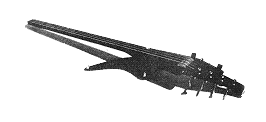
From the time the modern electric bass guitar was first developed by Leo Fender in the early 1950's, the basic configuration of solid body, bolt-on neck and enlarged headstock remained the mainstay in bass design for over thirty years, confirming Leo Fender's original vision.
Since the introduction of that breakthrough design, the Fender Precision bass, the majority of engineering enhancements had usually resulted in relatively minor permutations of this classic instrument design.
However, in spite of the dwindling supply of quality tonewoods and the concurrent development of new, high-tech materials & manufacturing techniques, modern instrument makers have tended to resist investigating possible avenues of improvement. Though understandable, this tendency has meant the continued degradation of tonewood stocks and a general avoidance of originality. In fact things regressed a bit in the '90's. With the exception of the Parker Fly, the most valid term to describe the music instrument industry was 'retro-obsessed' through the most recent decade.
In the late 1970's, an industrial designer with a background in sculpture and furniture design came across a new design challenge, one which also crossed into the fields of engineering and manufacture.
In the mid-seventies, Ned Steinberger shared space with bass luthier Stuart Spector in a Brooklyn, NY woodworking co-op. Spector approached Steinberger with the idea of looking for a new electric bass design. Applying himself to the problem, Steinberger developed a design classic - the Spector NS. This shape which has gone on to become one of the most successful modern bass designs, and later adopted and enhanced by the German bass manufacturer Warwick. Perhaps more importantly, Steinberger also became intrigued by several key engineering problems relating to bass guitar design, manufacture, and use.
Steinberger approached this engineering problem from a new perspective - one not beholden to the established approaches of the past.
The question Steinberger brought to the problem was this: what is the real function of a bass guitar? This functional rather than romantic approach resulted in a holistic reappraisal of the traditional breakdown of the design.
At its foundation the bass guitar - like any stringed instrument - is a system which must support string vibration. Acoustic coloration, amplification and player ergonomics, all vital aspects of the instrument, can only follow and never precede this basic function.
By reducing the design to the barest parameters Steinberger isolated the essential requirements of the instrument as used by the performer. He then applied available technological and manufacturing approaches to satisfy those requirements.
The first requirements isolated were as
follows:
To satisfy these requirements Steinberger discarded the traditional layout of the solid-body bass and eliminated the headstock, placing a tuning assembly behind the bridge of the instrument. Although not the first to make this change, he was the first to patent and manufacture instruments of this nature. Discarding the traditional double-cutaway body styling, which is more a concession to tradition than a vital part of the string-vibration support role of the instrument, Steinberger developed a minimal body-neck structure which eliminated some thirty percent of the weight and bulk of the instrument.
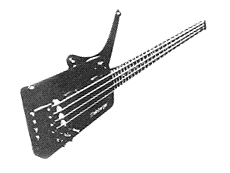 In addition, a pivoting contoured plate was installed close to
the center of gravity of the instrument, allowing the player an
unprecedented degree of comfort, balance and fretboard access.
In addition, a pivoting contoured plate was installed close to
the center of gravity of the instrument, allowing the player an
unprecedented degree of comfort, balance and fretboard access.
In this way the first three requirements of the design were all met, without regard for traditional biases of design or appearance. These requirements were surpassed when Steinberger used composite materials rather than wood to create the instrument.
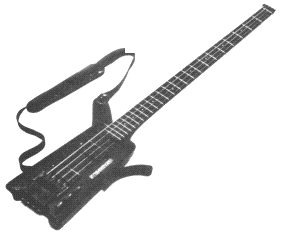
The Steinberger bass (shortly thereafter known as the 'L series' bass) was formally introduced in 1980, the first radically different and functionally conceived bass design since the inception of the electric bass by Leo Fender in 1951. Following the introduction and success of L, the lessons learned were applied to the instrument which Fender had also been pivotal in developing years earlier: the mass-produced solid body electric guitar.
In the years following the release of the Steinberger L bass, guitarists who had observed the many advantages of the design were eager for a six-string version. In 1983 the Steinberger GL was introduced. Originally incorporating a fixed-bridge, the guitar was soon given a floating tremolo system which, in combination with the 56:1 tuning ratio and double ball-end system, provided an unprecedented degree of pitch-bend variation while still returning to accurate concert tuning. At the same time a slightly revised version of the bass was also introduced and given the name XL to distinguish it from the guitar and the original L bass.
In 1984 the TransTrem was introduced, the most significant advancement on the tremolo design since Paul Bigsby developed his tremolo system in 1946. Allowing the guitarist to pitch-bend whole chords in correct tuning, the TransTrem also allowed the guitarist to increment or decrement the entire tuning of the instrument to five other keys: B, C, D, F# and G.
Although the Steinberger design eliminated many of the disadvantages of the traditional guitar and bass design, a second approach emerged in the products of the Steinberger Sound company.
Although responsible for inconsistent dynamic response, wooden construction has the aural effect of introducing characteristic resonances and artifacts which, following centuries of wooden string instrument construction, have become an normal part of the acoustic image expected by the listener. The varying aural characteristics of different tone-woods, from the 'bright' characteristics of maple to the 'dark' ones of mahogany, are an example of this dynamic. An acoustically perfect sound is not necessarily a more dynamic one.
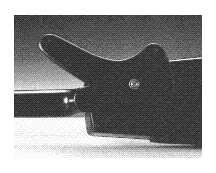 In the development leading up to the manufacture of the
Steinberger bass, experimentation was conducted using inconsistent
densities and types of reinforcing material through the neck-body
assembly. Rather than simply evenly distributing the material
through the epoxy resin, it was found that varying the placement and
alignment of the reinforcing material resulted in an enhanced audio
response that was both balanced and dynamic.
In the development leading up to the manufacture of the
Steinberger bass, experimentation was conducted using inconsistent
densities and types of reinforcing material through the neck-body
assembly. Rather than simply evenly distributing the material
through the epoxy resin, it was found that varying the placement and
alignment of the reinforcing material resulted in an enhanced audio
response that was both balanced and dynamic.
In response to request for a lower-cost version of the Steinberger design, maple bodies were joined to Steinberger Blend necks to provide freedom from dead spots and warpage. This move also had the effect of further introducing conventional wooden aural characteristics to the design. This concession came full circle in the 90's with the development of the Steinberger Spirits. They possess all of the appearance and functional features of the classic designs, while actually being made entirely of wood.
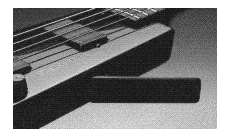 Several new manufacturers, including Brian Moore and Ken Parker,
have successfully combined the lessons of the Steinberger design
with those of traditional wood-based designs. This merges many of the
advantages associated with composite construction with a traditional
resonance signature which appeals to many instrumentalists.
Particular emphasis by these two aforementioned luthiers has been
placed upon the
emulation of acoustic guitar using piezo transducers.
Several new manufacturers, including Brian Moore and Ken Parker,
have successfully combined the lessons of the Steinberger design
with those of traditional wood-based designs. This merges many of the
advantages associated with composite construction with a traditional
resonance signature which appeals to many instrumentalists.
Particular emphasis by these two aforementioned luthiers has been
placed upon the
emulation of acoustic guitar using piezo transducers.
Although instrument designs come and go, particularly in the fashion-driven and categorical world of contemporary music, the Steinberger designs have attained the status of classic designs.
With a totally functional approach, free of transient concessions to form, the Steinberger XL and Steinberger GL guitars are exemplars of virtually perfect design.
Unlike the majority of production instruments which are carved by computer lathe, the Steinberger Blend instruments were made laboriously through the manual laying down of composite materials. This process ensured the highest possible quality from instrument to instrument. In reality, the degree of manual involvement required to make a Steinberger instrument was higher than that of many other mass-produced wooden musical instruments.
Using no wood in their construction, the Steinberger XL and GL left the world's diminishing supplies of tone woods intact. Environmentally inert, they can be taken almost anywhere in the world without warping or damage. Barring misadventure involving exceedingly high temperatures, they resist damage to a degree unthinkable before the development of synthetic materials. Typically finished in simple, flawless black, their minimal & modernist aesthetic transcends the ever-changing demands of postmodern fashion.
Their success cannot be measured only by their acceptance by instrumentalists world-wide, or by the effect the Steinberger design has had on instrument design and manufacturing. It is their complete satisfaction of the functional requirements of the stringed musical instrument which makes the Steinberger design a landmark in musical instrument manufacture, and industrial design.
By removing many of the concerns which come between the instrumentalist and his or her expression, the Steinberger design does what any good instrument should: enable and inspire the artist to communicate at an emotional and cognitive level, unimpeded by physical or material constraints.

Reprinted from the Geocities "Unofficial Steinberger Website" with some minor updates and revisions. Sadly this site was orphaned and has recently been removed. Luckily we saved some material, including this history page, and incorporated into this site. Thanks to the original author, whoever and wherever you are!
Click here for a link to the old official Steinberger timeline
Click here to see a comprehensive list of documentation including instructions, advertisements, catalogs, fliers and reviews